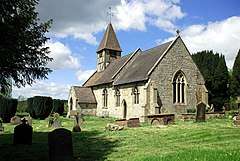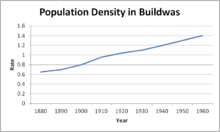Buildwas
Buildwas is a village and civil parish in Shropshire, England, on the north bank of the River Severn at grid reference SJ641045. It lies on the B4380 road to Atcham. The Royal Mail postcodes begin TF6 and TF8.
| Buildwas | |
|---|---|
 Buildwas Church | |
 Buildwas Location within Shropshire | |
| Population | 321 (2011)[1] |
| OS grid reference | SJ641045 |
| Civil parish |
|
| Unitary authority | |
| Ceremonial county | |
| Region | |
| Country | England |
| Sovereign state | United Kingdom |
| Post town | Telford |
| Postcode district | TF8 |
| Dialling code | 01952 |
| Police | West Mercia |
| Fire | Shropshire |
| Ambulance | West Midlands |
| UK Parliament | |
Buildwas Primary Academy is situated on the Buildwas bank road. The school has been running since 1855, and has three classes and a nursery.
Buildwas has a nine-hole golf course which runs between the River Severn and Ironbridge Power Station. It is open to members of Buildwas Abbey Club.
Village
The village of Buildwas has been recognised since 1086 as the first reference to it was made in the Domesday Book. Buildwas was valued at 45 shillings[2][3] (£2.25) to the Bishop of Chester, i.e. the Bishop of Lichfield and Coventry, the local diocesan bishop, in 1086. The value of the manor was the same as in 1066, although it had slipped in the interim period. Its value lay in its location on the River Severn its woodland, which was useful for agricultural and farming purposes. During this time period, the village had a total population of nine households, three of villeins, five of slaves and one the reeve. Due to this the village only had a total tax assessment of one geld unit which was very small. Buildwas had resources of 200 pigs and a mill which people relied on. The manor was assigned to Buildwas Abbey, originally founded as a Savigniac monastery, in 1135 by Roger de Clinton[4] (1129–1148), Bishop of Coventry and Lichfield. The Savigniac houses were later absorbed into the Cistercian order. After the abbey was suppressed in 1536, as part of the Dissolution of the Monasteries, the site and much of the property was granted to Edward Grey, 3rd Baron Grey of Powis[5]
Occupations

The first census regarding occupational data for the village of Buildwas was taken in 1831 and gives a valuable insight into the village for this time period. The census showed that the biggest employability sector at this time was agricultural labourers, and there were 35 people employed in this field.[6] The second biggest field was retail and handicrafts, which employed seven people in the village. There was one capitalist or professional person within the village and the remaining people were farmers and servants.[6]
The 1881 census of the village gave valuable insight into how the population had slowly increased and how the jobs had diversified. Agriculture was still the biggest employment sector with 41 people but other job fields had grown over the course of fifty years.[6] There were fifteen females and eight males employed in domestic services and offices. There were twelve males employed in the extraction of mineral substances and three people who worked in transport and commerce. There were forty people in the survey who were classified as having an unknown occupation and three male workers in food and lodging.
Population

Population change in Buildwas has experienced a great deal of fluctuation since the first census of 1801 was taken. This is because the village had a small population of 258 to begin with in the first place meaning that any change is a lot more visible.[6] In 1811 the population had declined to 226 people but then experienced a gradual increase to 240 people in 1821 and stayed at this level through to 1831. Over the next ten years, the village had experienced a rapid population increase of 33 people in 1841 and in 1851 the population had increased again to 290 people. From 1851 to 1881 there had been a population decrease of eighteen people. During 1881 there was a national population change across the country with an overall decrease of 3% and this change of population was apparent in Buildwas as from 1881 to 1891 there was a population decrease of thirty-one people. The population increased by thirty-four people in 1901 and by 1911 the population had increased by thirty-two people.
Housing
According to the 2001 Census, Buildwas had a total of 134 dwellings. Of these, 42 were categorised as being flats or apartments, 46 detached houses or bungalows, and 46 semi-detached or terraced houses.[7] The average price of property which has been sold in Buildwas was valued at £218,114[8] which was well above the national average of £161,558 in April 2012.[9]
Visiting Buildwas
Buildwas Abbey
The preserved remains of a Cistercian abbey lie on the south bank of the River Severn. These include an unusually unaltered 12th-century church, a vaulted and tile-floored chapter house, and a re-opened crypt chapel.[10] The stone abbey was buildings were completed mainly during the abbacy of Ranulf, which began around 1155.[11] The income for the abbey came mainly from a large portfolio of properties, concentrated around monastic granges in the surrounding areas of Shropshire and Staffordshire. The site is now cared for by English Heritage.[12]
Bridge
.jpg)
A brick and stone bridge crossed the Severn from medieval times to the 18th century; in floods of 1773 and 1795, it was irreparably damaged and finally swept away by severe flooding following an earthquake.[13] After its destruction, Thomas Telford built a cast-iron arch bridge in 1796, which survived subsequent floods until its replacement by a steel Pratt truss in 1905, which itself was replaced in 1992.[14]
See also
- Listed buildings in Buildwas
- Ironbridge Gorge
- Buildwas Junction railway station
- Telford Steam Railway
References
| Wikimedia Commons has media related to Buildwas. |
- "Civil Parish population 2011". Retrieved 23 November 2015.
- Buildwas in the Domesday Book
- Domesday text translation at Open Domesday: SHR 1,7.
- L. Janauschek. Originum Cisterciensium, p. 104
- Victoria County History – Shropshire: House of Cistercian monks: Abbey of Buildwas
- "Vision of Britain". University of Portsmouth. Retrieved 30 April 2012.
- "Neighbourhood Statistics". Directgov. Retrieved 30 April 2012.
- "FindaProperty.com". FindaProperty.com. Retrieved 30 April 2012.
- "Land Registry". Land Registry. Retrieved 30 April 2012.
- "English Heritage". English Heritage. Retrieved 1 May 2012.
- Victoria County History – Shropshire: House of Cistercian monks: Abbey of Buildwas
- "Visiting Buildwas". Beth Heath. Retrieved 1 May 2012.
- "Buildwas Bridge and the Severn Earthquake of 1773". revolutionaryplayers.org.uk. Retrieved 7 May 2017.
- "Buildwas Bridge, site of". engineering timelines. Retrieved 7 May 2017.